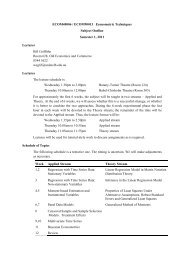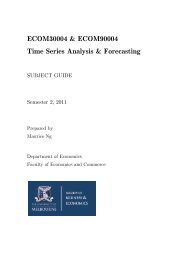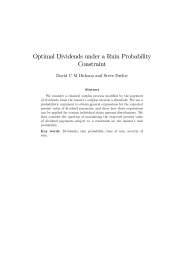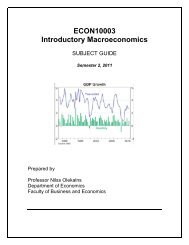A Model of Optimal Corporate Bailouts - Faculty of Business and ...
A Model of Optimal Corporate Bailouts - Faculty of Business and ...
A Model of Optimal Corporate Bailouts - Faculty of Business and ...
Create successful ePaper yourself
Turn your PDF publications into a flip-book with our unique Google optimized e-Paper software.
extended the “too big to fail” guarantee <strong>and</strong> its associated moral hazard to nonfinancialfirms. The implication may seem to be that any company in America canreceive a government backstop, so long as its collapse would cost enough jobs ordeal enough economic damage. (Congressional Oversight Panel (2011), at 185).Our model was designed to help frame <strong>and</strong> assess these concerns. It extended a canonicalagency model to explore the trade-<strong>of</strong>fs <strong>of</strong> governmental interventions when tax-financedbailouts—even as they help third-party stakeholders—could indeed exacerbate moral-hazardproblems in firms.There are three key policy insights that emerged from our model. First, although bailoutscan be both feasible <strong>and</strong> efficiency enhancing, <strong>and</strong> even for firms outside the financial sector,the government should be cognizant <strong>of</strong> its negative effects <strong>and</strong> use bailouts sparingly, rescuingonly those distressed firms where external stakes are significant <strong>and</strong> bailout costs are modest.Second, the government should usually expropriate existing owners <strong>and</strong> management in anybailouts, not just because failed managers are more likely incompetent, but because this reducesthe moral hazard that bailouts create. And third, the government should not finance bailoutsthrough extraordinary levies on bailed-out firms, but through levies on healthy firms.ATechnical AppendixA.1 Necessary <strong>and</strong> Sufficient Conditions For an Interior First-BestSolutionThis appendix describes the necessary <strong>and</strong> sufficient conditions for e FB1For e FB2to be interior, there are two conditions:<strong>and</strong> eFB2to be interior.1. Expected social welfare in the time-2 continuation game must be weakly positive, (R + S)2sv 2 ( e FB2 ) = (R + S)2− I 2 ≥ 0 ⇔ I 2 ≤ .2·c2·c2. The first-order condition cannot induce an effort level exceeding 1,For e FB1(R + S)≤ 1 ⇔ c ≥ R + S .cto be interior, there are two binding conditions:1. It must be thatR + S−c(R + S)22·c 2 + I 2c(R + S)2≥ 0 ⇔ I 2 ≥ − (R + S) .2·c30
















